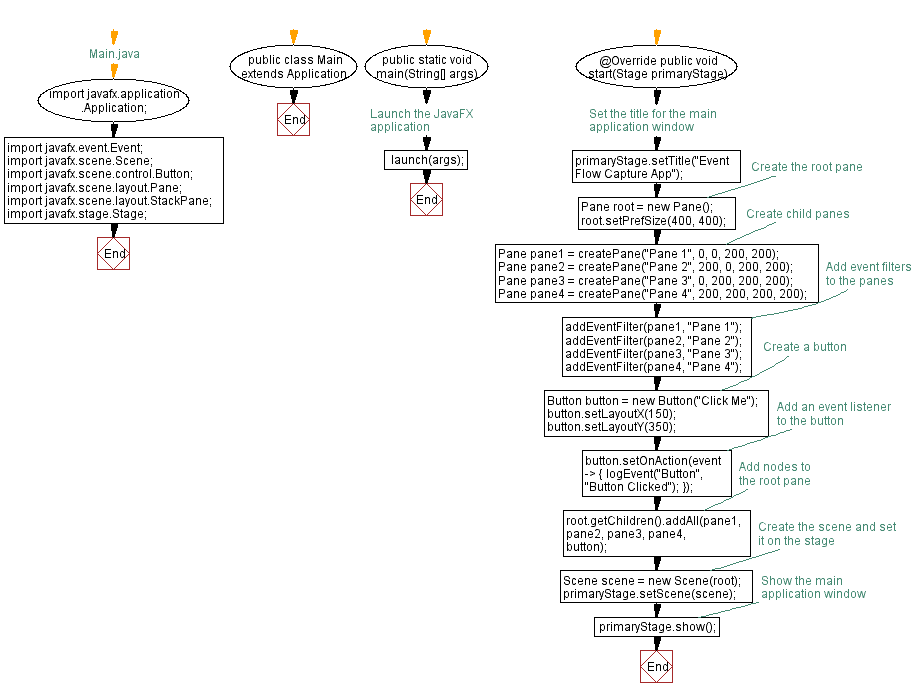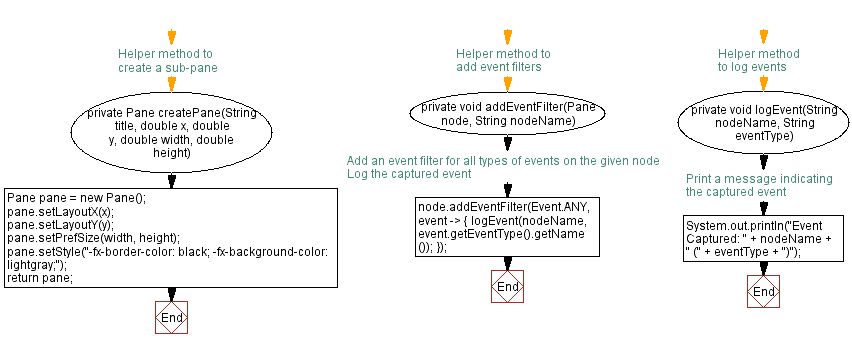JavaFX event flow capture with nested panes
9. Nested Panes Event Filtering
Write a JavaFX application with multiple nested panes. Implement event filters to capture and log the event flow when an action occurs.
Sample Solution:
JavaFx Code:
//Main.java
import javafx.application.Application;
import javafx.event.Event;
import javafx.scene.Scene;
import javafx.scene.control.Button;
import javafx.scene.layout.Pane;
import javafx.scene.layout.StackPane;
import javafx.stage.Stage;
public class Main extends Application {
public static void main(String[] args) {
// Launch the JavaFX application
launch(args);
}
@Override
public void start(Stage primaryStage) {
// Set the title for the main application window
primaryStage.setTitle("Event Flow Capture App");
// Create the root pane
Pane root = new Pane();
root.setPrefSize(400, 400);
// Create child panes
Pane pane1 = createPane("Pane 1", 0, 0, 200, 200);
Pane pane2 = createPane("Pane 2", 200, 0, 200, 200);
Pane pane3 = createPane("Pane 3", 0, 200, 200, 200);
Pane pane4 = createPane("Pane 4", 200, 200, 200, 200);
// Add event filters to the panes
addEventFilter(pane1, "Pane 1");
addEventFilter(pane2, "Pane 2");
addEventFilter(pane3, "Pane 3");
addEventFilter(pane4, "Pane 4");
// Create a button
Button button = new Button("Click Me");
button.setLayoutX(150);
button.setLayoutY(350);
// Add an event listener to the button
button.setOnAction(event -> {
logEvent("Button", "Button Clicked");
});
// Add nodes to the root pane
root.getChildren().addAll(pane1, pane2, pane3, pane4, button);
// Create the scene and set it on the stage
Scene scene = new Scene(root);
primaryStage.setScene(scene);
// Show the main application window
primaryStage.show();
}
// Helper method to create a sub-pane
private Pane createPane(String title, double x, double y, double width, double height) {
Pane pane = new Pane();
pane.setLayoutX(x);
pane.setLayoutY(y);
pane.setPrefSize(width, height);
pane.setStyle("-fx-border-color: black; -fx-background-color: lightgray;");
return pane;
}
// Helper method to add event filters
private void addEventFilter(Pane node, String nodeName) {
// Add an event filter for all types of events on the given node
node.addEventFilter(Event.ANY, event -> {
// Log the captured event
logEvent(nodeName, event.getEventType().getName());
});
}
// Helper method to log events
private void logEvent(String nodeName, String eventType) {
// Print a message indicating the captured event
System.out.println("Event Captured: " + nodeName + " (" + eventType + ")");
}
}
Sample Output:
. . . . . . . . . . . . . . . . . . . . . Event Captured: Pane 3 (MOUSE_MOVED) Event Captured: Pane 3 (MOUSE_MOVED) Event Captured: Pane 3 (MOUSE_MOVED) Event Captured: Pane 3 (MOUSE_MOVED) Event Captured: Pane 3 (MOUSE_MOVED) Event Captured: Pane 3 (MOUSE_MOVED) Event Captured: Pane 3 (MOUSE_EXITED) Event Captured: Pane 3 (MOUSE_ENTERED) Event Captured: Pane 3 (MOUSE_MOVED) Event Captured: Pane 3 (MOUSE_EXITED) . . . . . . . . . . . . . . . . . . . . .
Flowchart:


Go to:
PREV : Login Form with Action Listener.
NEXT : Tree UI with Event Propagation.
Java Code Editor:
What is the difficulty level of this exercise?
Test your Programming skills with w3resource's quiz.
